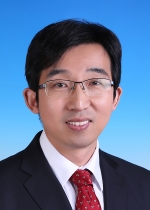教师简介
| 姓名: | 韩建永 | 
|
| 性别: | 男 |
| 系别: | 生物化学与分子生物学 |
| 职称: | 教授 |
| 学位: | 博士 |
韩建永 教授,博士生导师。
2006年获中国农业大学生物化学与分子生物学博士;2006-2010年于新加坡基因组研究院(Genome Institute of Singapore)从事干细胞与发育生物学科研工作;2010年提升为Research Scientist;2011年以“拔尖人才”引进中国农业大学生物学院工作。
学习与工作经历
1、教育经历
1993.9-2000.7 河北农业大学,动物科技学院,攻读本科、硕士学位
2003.9-2006.7 中国农业大学,生物学院,攻读博士学位
2、工作经历
2000.07-2003.09 河北农业大学,动物科技学院,助教、讲师
2006.10-2011.03 新加坡基因组研究院,博士后、助理研究员、研究院(Research Scientist)
2011.03-至今 中国农业大学生物学院,教授、博士生导师
研究方向
(1)早期胚胎发育及其调控机制 利用单细胞技术如单细胞转录组检测等解析小鼠、大家畜(猪、牛等)早期胚胎发育分化以及多能性调控机制,为高质量多能干细胞建系和胚胎工程实施提供理论依据。
(2)猪等大动物初始态(naive)胚胎干细胞建系 分离具有生殖系嵌合能力的猪等大动物胚胎干细胞,为临床医学和畜牧业提供模型细胞和种质细胞。
(3)干细胞多能性和体细胞重编程调控机制解析 利用基因编辑、体细胞核移植(克隆)显微操作以及诱导多能干细胞(iPSC)等技术平台,结合基因组水平测序和分析等分子生物学技术手段和方法研究多能干细胞质量影响因子、体细胞重编程机理和相关发育生物学问题。
(4)细胞模型和动物模型构建 结合基因编辑和多能干细胞技术,针对临床疑难疾病和畜牧业生产性状,研制细胞模型和动物模型,为攻克人类重要疾病、提高动物生产性状和抗病能力提供技术平台。
(5)干细胞新技术研发 在实验室已有技术平台基础上,研发适用于科研和生产的新技术,如干细胞重构胚胎样结构等。
主讲课程
研究生课程:《高级动物生理学》
本科生课程:《动物克隆与转基因》、《生命科学导论》
联系方式
电话:010-62734382
邮件:hanjy at cau.edu.cn
通讯地址:北京市海淀区圆明园西路2号中国农业大学西校区生命科学研究中心 邮编:100194
发表文章(代表文章)
1. Shaopeng Zhang, Tianzhi Chen, Naixin Chen, Dengfeng Gao, Bingbo Shi, Shuangbo Kong, Rachel C. West, Ye Yuan, Minglei Zhi, Qingqing Wei, Jinzhu Xiang, Haiyuan Mu, Liang Yue, Xiaohua Lei, Xuepeng Wang, Liang Zhong, Hui Liang, Suying Cao, Haibin Wang, Juan Carlos Izpisua Belmonte, Jianyong Han*. Implantation initiation of self-assembled embryos generated using three types of mouse blastocyst-derived stem cells. Nature Communications. 2018 Dec (Accepted) (*Corresponding author)
2. Xu J, Yu L, Guo J, Xiang J, Zheng Z, Gao D, Shi B, Hao H, Jiao D, Zhong L, Wang Y, Wu J, Wei H, Han J*. Generation of pig induced pluripotent stem cells using an extended pluripotent stem cell culture system. Stem Cell Res Ther. 2019 Jun 27;10(1):193. doi: 10.1186/s13287-019-1303-0. (*Corresponding author)
3. Lineage specification revealed by single-cell gene expression analysis in porcine preimplantation embryos. Wei Q, Li R, Zhong L, Mu H, Zhang S, Yue L, Xiang J, Li E, Zhi M, Cao S, Han J*. Biol Reprod. 2018 Aug 1;99(2):283-292. doi: 10.1093/biolre/ioy062. PMID: 29546319 (*Corresponding author)
4. Xiang J, Cao S, Zhong L, Wang H, Pei Y, Wei Q, Wen B, Mu H, Zhang S, Yue L, Yue G, Lim B, Han J*. Pluripotent stem cells secrete Activin A to improve their epiblast competency after injection into recipient embryos. Protein Cell. 2018 Aug;9(8):717-728. doi: 10.1007/s13238-017-0470-y. Epub 2017 Oct 12. (*Corresponding author)
5. Wei Q, Zhong L, Zhang S, Mu H, Xiang J, Yue L, Dai Y, Han J*. Bovine lineage specification revealed by single-cell gene expression analysis from zygote to blastocyst. Biol Reprod. 2017 Jul 1;97(1):5-17. (*Corresponding author)
6. Wang H, Xiang J, Zhang W, Li J, Wei Q, Zhong L, Ouyang H, Han J*. Induction of Germ Cell-like Cells from Porcine Induced Pluripotent Stem Cells. Sci Rep. 2016, 6:27256. (*Corresponding author)
7. Wang Y, Li J, Xiang J, Wen B, Mu H, Zhang W, Han J*. Highly efficient generation of biallelic reporter gene knock-in mice via CRISPR-mediated genome editing of ESCs. Protein Cell. 2016, 7(2):152-6. (*Corresponding author)
8. Pei Y, Yue L, Zhang W, Wang Y, Wen B, Zhong L, Xiang J, Li J, Zhang S, Wang H, Mu H, Wei Q, Han J*. Improvement in Mouse iPSC Induction by Rab32 Reveals the Importance of Lipid Metabolism during Reprogramming. Sci Rep. 2015, 5:16539. (*Corresponding author)
9. Zhang W, Pei Y, Zhong L, Wen B, Cao S, Han J*. Pluripotent and Metabolic Features of Two Types of Porcine iPSCs Derived from Defined Mouse and Human ES Cell Culture Conditions. PLoS One. 2015 Apr 20;10(4):e0124562. (*Corresponding author)
10. Cao S, Han J*, Wu J, Li Q, Liu S, Zhang W, Pei Y, Ruan X, Liu Z, Wang X, Lim B, Li N. Specific gene-regulation networks during the pre-implantation development of the pig embryo as revealed by deep sequencing. BMC Genomics. 2014 Jan 3;15(1):4. doi: 10.1186/1471-2164-15-4. (*Corresponding author)
11. Cao S, Loh K, Pei Y, Zhang W, Han J*. Overcoming barriers to the clinical utilization of iPSCs: reprogramming efficiency, safety and quality. Protein Cell. 2012 Nov;3(11):834-45. (*Corresponding author)
12. Han X*, Han J*, Ding F, Cao S, Lim SS, Dai Y, Zhang R, Zhang Y, Lim B, Li N. Generation of induced pluripotent stem cells from bovine embryonic fibroblast cells. Cell Research. 2011, 21(10):1509-12. (*These authors contributed equally to this work.)
13. Jianyong Han, Ping Yuan , Henry Yang, Jinqiu Zhang, Junliang Tay, , Boon Seng Soh, Pin Li, Siew Lan Lim, Cao Suying, Yuriy Orlov, Thomas Luftkin, Huck-Hui Ng, Wai-Leong Tam, Bing Lim. Tbx3 improves the germ-line competency of induced pluripotent stem cells. Nature, 2010, 463(7284):1096-1100.
14. Heng JC, Feng B, Han J*, Jiang J, Kraus P, Ng JH, Orlov YL, Huss M, Yang L, Lufkin T, Lim B, Ng HH. Nuclear Receptor Nr5a2 replaces Oct4 in the Reprogramming of Murine Somatic Cells to pluripotent cells. Cell Stem Cell, 2010, 6(2):167-174. (*These authors contributed equally to this work.)
15. Yuan P*, Han J*, Guo G, Orlov YL, Huss M, Loh YH, Yaw LP, Robson P, Lim B, Ng HH. Eset partners with Oct4 to restrict extraembryonic trophoblast lineage potential in embryonic stem cells. Genes Dev. 2009, 23(21):2507-20. (*These authors contributed equally to this work.)
16. Feng B, Jiang J, Kraus P, Ng JH, Heng JC, Chan YS, Yaw LP, Zhang W, Loh YH, Han J, Vega VB, Cacheux-Rataboul V, Lim B, Lufkin T, Ng HH. Reprogramming of fibroblasts into induced pluripotent stem cells with orphan nuclear receptor Esrrb. Nat Cell Biol. 2009, 11(2):197-203.
获奖情况
承担项目及课题
国家干细胞重点研发项目课题
国家自然科学基金项目
人才项目:高层次人才支持计划
重点实验室自主重大项目
专利情况
社会兼职
国际干细胞学会会员
中国畜牧兽医学会高级会员
中国动物繁殖学会常务理事

